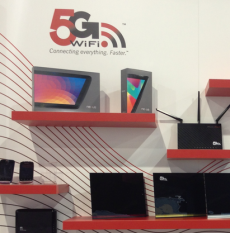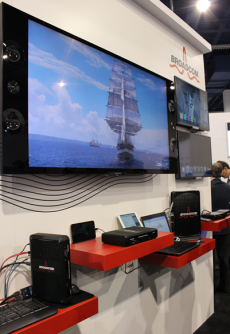
Broadcom CEO: life after LTE, 5G cellular exit
If you did, you were right.
Noting that his company was losing about $2 million a day in the modem business, McGregor, who looked almost relieved, proudly pointed to the Broadcom booth and bragged, “We have no cell phones.”
The company’s focus is now on the broadband and connectivity businesses. “Our broadband is an extremely strong and valuable business. Our connectivity business is also very strong, and is focused more on the Internet of Things now,” he said. “Frankly, these are better businesses to be in and invest in.”
The company is broadening its technology and businesses. These include connected homes, and more recently, automotive. McGregor called the automotive segment “a great business we are sort of tiptoeing into” and finding it “very interesting.”
EE Times caught up with McGregor last week during CES and asked him how the company’s decision to not participate in the baseband business is likely to affect Broadcom in the future. Here’s an excerpt of our conversation.
EE Times: Broadcom got out of the baseband modem business. Could you explain how you reached the decision?
McGregor: It was a very painful decision. The reason for doing that was a couple of fold. One was that we saw the deteriorating condition in the economics of that business in terms of pricing and margins. There were a number of players in the space who didn’t care whether they made money or not. And they had imperatives to be in that business at all costs. It’s a little different from how we run Broadcom as a for-profit company.
We also felt that to be successful in that market, the economics necessitated that you have an extremely high market share. So, you can’t be successful by being the number four or five player. You had to be either in the top two or three, or you’re not going to make any money.
We reflected on that, and thought, gee, there are a lot of other things we can do with that money. You don’t have to be in a bad economic business. You choose to be in the bad economic businesses.
We decided not to be in the business. But again, it was a painful decision, because we laid off quite a few people. We terminated about 2,500 people, of which 500 people found jobs elsewhere in Broadcom. But the net was about 2,000 people who left the company. Many of them were very good people. So, you never feel good about that.
On the other hand, since we’ve done that, we’ve seen the profitability of the company dramatically increase. I mean, we were losing about $2 million a day in that [baseband] business …so now, we are able to invest more in the products you see here.
EE Times: We understand that broadband and connectivity are Broadcom’s bread-and-butter, and you guys are doing a great job.
But I always thought the whole reason for Broadcom’s entry into the baseband business was that you wanted to become a chip supplier for the entire smartphone system, including baseband and apps processors. Now that you’re out of the baseband modem business, where will that leave you in the smartphone business in the future?
McGregor: So, if you think about the connectivity business, we won all of that business without any baseband participation. We never really had a high share in the baseband. We had a strong number one position in connectivity — and again, all without the benefit of baseband. That would have been on top of that share.
The reason we win in connectivity is because we have very strong execution across the broad range of technologies. And we are really good at integrating different connectivity technologies. We are creating a platform out of connectivity technologies. And that doesn’t change.
The other thing is that there has always been an issue with time to get connectivity and baseband out because of the different cadence between the two. Baseband changes at a rate about half the rate connectivity changes. For every generation you go through with baseband, you probably go through two generations of connectivity.
If you ever put them together in the same chip, then, you will disadvantage the connectivity substantially — because it will be on average, one generation behind. So, that’s problematic, certainly for high-end and in some cases mid-range chips, but less so on low-end.
Chinese fabless are also getting into connectivity
EE Times: With all the capital going into the Chinese semiconductor industry, I hear that a lot of Chinese fabless companies have money to burn. They’ve begun licensing connectivity technologies from others because they want to be in that business [of modem and connectivity] for smartphones.
Shanghai-based Spreadtrum, a successful vendor of baseband chips but with no connectivity solutions, recently licensed connectivity IP core — such as Bluetooth Low Energy – from Ceva. And Spreadtrum isn’t alone making such deals.
Now, to me, that means trouble for Broadcom. No?
McGregor: Oh, potentially. But you can make the same argument about Samsung LSI or Huawei. But at the end of the day, they use our connectivity chips. There are big differences between the best and almost the best… or not at all the best. I think people want to have the best technologies in these spaces. You need that to win specs, market values, and there are a lot of features you enable with these products.
To give you an example, GPS has been an area that we’ve differentiated for a while. There is a big difference in how many constellations you see. If you can see one more satellite, because you include European’s Galileo satellite and others don’t, it makes a huge difference in driving down a city street in New York.
EE Times: Now that you are out of the LTE modem business, are out of the race or out of the running for 5G wireless?
McGregor: 5G cellular, we’re not working on that. But 5G WiFi, that’s our domain. We pioneer that technology. Absolutely, that’s our strength and we will continue that.
EE Times: So, why does Broadcom feel confident not participating in 5G cellular?
McGregor: Well, today, that’s where we decided to spend less money. So, we can spend more money on other things. It means we will not have necessarily 5G baseband technology. We could reenter the market sometime if market economics change, but you know, today, we think investment is better spent on other things.
Broadcom CEO on IoT, iGrill and 4K UHDTV
EE Times: What have you seen on the show so far?
McGregor: Customers who come through today are finding our automotive platform also applies to avionics. We are finding the Internet of Things makes a lot of sense for devices we’ve never thought of. I met with a customer, one of the largest makers of kitchen appliances. They told us they are going to put Wi-Fi in pretty much all of their appliances.
You know, for an average American, it’s sort of a head scratcher. “Why would anyone want to connect an oven with Internet?”
There are two economic drivers of it. One, utility companies are really interested when you use appliances and they will collect data for managing plants. And they will pay money for that data.
Two, as a consumer, wouldn’t you like to be able to pre-heat the oven on the way home from work? Sometimes, that’s kind of nice. Or, for absent-minded people, “Oh, my God, I’m on vacation. Did I leave the oven on?”
EE Times: Did you see the oven with a camera inside at Panasonic’s booth? You can see what’s going on inside the oven — how it is browning, etc. — without opening the door.
McGregor: There’s a camera inside? Cool… Oh, I love that.
I just got for this Christmas this thing called iGrill. Do you know what that is? I love it. I made chicken the next day. I put the probes in the oven, and I sat down with a bunch of my family in the living room and I was watching the chicken cook on my smartphone.
EE Times: That’s an IoT coming to the kitchen story.
McGregor: I think there are a couple of themes at the show. One is that the Internet of Things has moved beyond just a total geek field. Mainstream consumers are starting to understand how they might actually like to have some of these devices. Price points are beginning to come down and the quality is going up. This will be an ongoing process. It’s not a binary thing.
You know there’s still a lot of lame stuff out there. I can’t believe how many drones are there on the show floor. Zzzt, there you go!
EE Times: There is a special drone section at the show this year.
McGregor: The other trend I saw on the show floor is that 4K, UHDTV and content are becoming mainstream. We’ve seen demos and stuff in the last few years. But now there are reasonably priced 4K TV sets and there’s content available. That’s important for us, of course, because we produce all the chips that go into all the set-top boxes. A whole lot of stuff we produce and you see here in the booth this year are enabling 4K this and that.
EE Times: But none of the cable guys are doing 4K today. Are they?
McGregor: They’re all working on it. I mean, all of them. If they don’t have a plan to deploy it, they’ll be out of business. Because consumers are going to buy a 4K TV set, and if their cable provider does not offer 4K content, they will change. They’ll go to a satellite provider, or to streaming guys offering 4K. So, there is competition. It’s going to move fairly rapidly.
It’s going to be completely different from the 3D phenomenon we saw five years ago. That was a big splash here at the CES and everyone was wearing those stupid glasses.
EE Times: Qualcomm is showing a glassless 4K 3D display. That was pretty neat.
McGregor: Yeah…but my experiences with those is that you have to stand in exactly the right spot. In my living room, where the sofa is at an angle to the TV, this would never work. Those are useful for a single shooter game.
EE Times: What’s your take on Android TV?
McGregor: We support it on our set-top boxes.
EE Times: So, that would be like an OTT set-top box?
McGregor: Think of it as a box that has a processor and all of the content comes in and you can run applications. It’s interesting that all these guys are trying to figure out how to get the ecosystem of applications to critical mass. Roku TV is trying to do that, there’s Android TV, and obviously big guys like Samsung and others. It would be interesting to see how they come together and how they play. Our view is agnostic and we support all of them.
No iPhone moment for IoT yet?
EE Times: One more thing. I was talking to ARM yesterday. We were saying that we haven’t experienced the “iPhone moment” for IoT yet. What’s your view on this?
McGregor: Well, let me give you a positive story and a negative story. The positive story is that IoT is the Holy Grail, and something companies are working on. The challenge of our industry is to create things that play better together. We’re working on standards, and certainly companies themselves who are making multiple products are making sure they work together. Many customers I talk to are focused on the quality of the user experience. That’s the positive side of the story.
The negative side of the story, if you go to my living room or probably your living room, you will find a pile of remote controls on the coffee table. My wife says, “It’s so hard to just figure out how to do anything.” She has to turn on one thing before another thing…”So, let’s see, I want to go Amazon streaming. Do I do it on a set-top box or do I do it on a TV? Which one is it? Otherwise, I’d push the wrong button.”
…and I am pessimistic about that coming together for a couple of reasons.
One is that the reason we don’t have great universal controls is not because it’s impossible to create one. But it’s just because each vendor out here has unique features and unique values. And you have a choice on remote control, user interface or user experience. Creating the lowest common denominator that will work across every brand and mixture… that’s not very interesting, because those are all the cool stuff.
EE Times: Do you believe any open standard groups will affect the ease of connectivity?
McGregor: I think they’ll try. And over time, they’ll definitely do it. I mean, we have solved the problem…like when we go to a rental car, and pretty much figure out how to drive it. But it’s a little disorienting when you go to a new car. Braking, accelerator and ignition are generally obvious where they are. But when I go looking for a turn signal, windshield wiper or turn on lights, that’s not always obvious where those are. This is an example of a highly standardized industry and it’s been around for a long time. And they can’t do it.
So…expecting that we are going to do it in an even more sophisticated set of devices may be something inherently difficult. When companies are trying to create their user experience, different from others, and if we try to force them together, they’d said, “Wait a minute. We’ll lose our brand identity.”
 If you enjoyed this article, you will like the following ones: don't miss them by subscribing to :
eeNews on Google News
If you enjoyed this article, you will like the following ones: don't miss them by subscribing to :
eeNews on Google News








